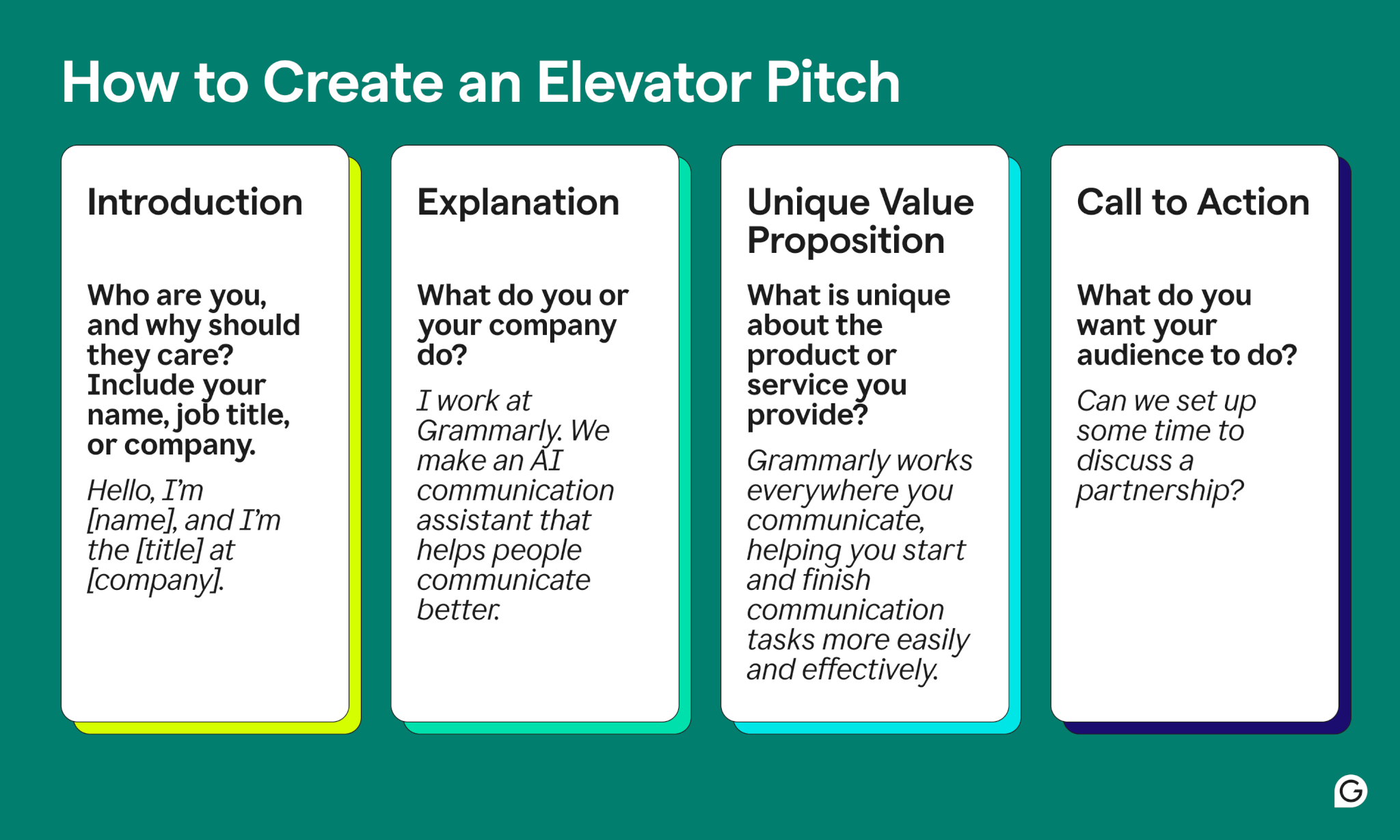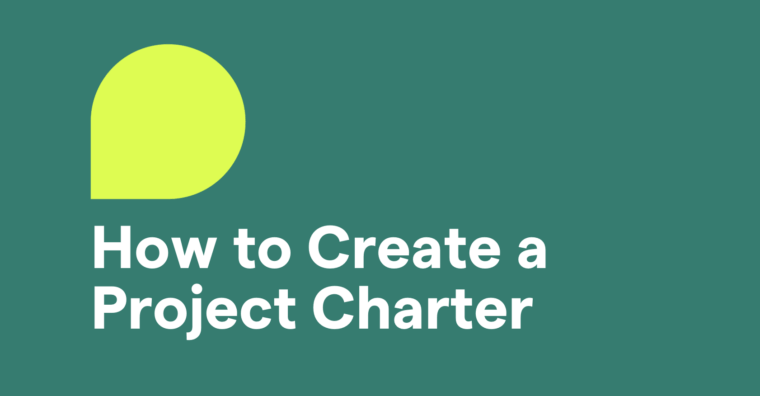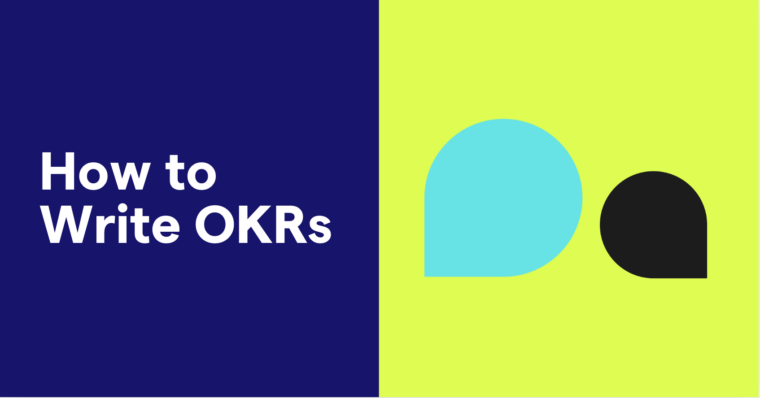
- An elevator pitch is a memorable, succinct summary of who you are and what you do, typically given in a professional setting.
- Elevator pitches should be about 30–60 seconds or 50–200 words.
- The best situations to use elevator pitches are networking, job interviews, sales, or presentations.
- An effective elevator pitch introduces you or your company, explains what you do, describes what makes you special, and elicits a follow-up action from the listener.
Opportunity can strike anywhere and at any time, so always be prepared. What if you coincidentally meet someone who could help you with your business or career, but you only have a limited amount of time to make a good impression—such as the length of an elevator ride? That’s why a lot of professionals have an elevator pitch ready to go; if you only have a few seconds to introduce yourself, you don’t want to waste them thinking about what to say.
For professionals at every level, elevator pitches or elevator speeches are a useful tool for networking and business conversations. In this guide, we explain how to write an elevator pitch for different occasions and share some quality elevator pitch examples to help you write your own.
Table of contents
How long should an elevator pitch be?
Elevator pitch example from Grammarly
When should you use an elevator pitch?
How to write an elevator pitch
Dos and don’ts of how to write an elevator pitch
What is an elevator pitch?
An elevator pitch is a memorable, succinct summary of who you are, what you do, what you want to do, or what you sell. Sometimes called an elevator speech, an elevator pitch can be about you, your company, your product, or your personal brand.
The term elevator pitch comes from the idea that you should be able to explain your work or project in under a minute—about the amount of time you’d be riding in a theoretical elevator with a potential investor, editor, lawmaker, or hiring manager on their way to work or a meeting.
An elevator pitch can be a conversation starter, an interview introduction, a sales pitch, or whatever else you need to produce the desired effect. The goal of the elevator pitch is to act as a professional introduction and a way to get a second, more detailed conversation with people who can help your mission.
You might use an elevator pitch during job interviews, trade shows, sales calls, or fundraising campaigns, to list some examples. Elevator speeches are a way to introduce yourself or your product that’s convincing enough to win you a more persuasive conversation later.
How long should an elevator pitch be?
The main characteristic of elevator pitches is that they’re brief. Like asking for a promotion, the idea is that you “sell” yourself as quickly as possible, in case you don’t have a lot of time or a second meeting is not guaranteed. Therefore, elevator pitches are heavily condensed summaries that should only be a few sentences (but more than one, to avoid a run-on sentence). They should take the amount of time for an elevator ride.
To put it into specific terms, an elevator pitch should be about 30–60 seconds. When you’re writing one, plan for 50–200 words. However, some occasions afford you more time than others, such as introducing yourself in a job interview, so it’s common to have shorter and longer versions of your elevator pitch to accommodate different scenarios.
Elevator pitch example from Grammarly
Written by Grammarly AI:
Hi, I’m [Your Name], a wildlife biologist with five years of experience in habitat restoration. I specialize in creating and executing conservation strategies that enhance biodiversity. I’m passionate about collaborating with teams to drive impactful projects that rejuvenate ecosystems. Could we connect to see if my skills align with your needs?
When should you use an elevator pitch?
Selling yourself in an elevator pitch isn’t right for every situation. You may find that some scenarios will require the information you share to be more nuanced. If you find yourself in an environment where formally pitching yourself is too uncomfortable or inappropriate, maybe asking questions and casually introducing yourself will make more sense.
You also don’t need to use an elevator pitch in an informal interview or at a meal. If someone in these situations wants your pitch, they’ll ask you for it. These are generally casual, get-to-know-you situations, so a formal pitch would be out of place.
Elevator pitches are most effective in professional settings, such as job interviews, networking, sales conversations, and presentations. Sometimes, you may even get to use your elevator pitch on an elevator!
Job interview
You can usually count on a job interviewer asking you to “tell me about yourself,” so you might as well prepare a reliable answer. Elevator pitches are a good way to introduce yourself to a prospective employer and give them your basic story before answering their specific questions with more details.
Networking
The best professional networkers seize every opportunity. You never know whom you’re going to meet or where, so if you suddenly find yourself face-to-face with someone who can help your career, a preplanned elevator pitch can help immensely. They’re also useful for strategic outreach, as in a connection request message on LinkedIn.
Writing and practicing an elevator pitch in your spare time prepares you for these rare chances so you don’t fumble or forget to mention something.
Sales conversations
Elevator pitches work great as sales techniques because both benefit from being short and sweet. An elevator pitch converted to sales will introduce the product, explain its benefit (unique value proposition), and attempt to close all in just a few seconds. These work great on the sales floor, as well as at trade shows or conventions where you’re meeting a lot of potential customers but don’t have much time with each.
Presentations
As in sales, the direct and to-the-point format of an elevator pitch works well for business or academic presentations. Opening your presentation with an elevator pitch establishes your credentials and hooks the audience in the first moments, leaving you free to expand on the details for the rest of your time.
How to write an elevator pitch
An effective elevator pitch contains four parts:
- Introduction
- Explanation
- Unique Value Proposition
- Call to Action

Keep in mind that an elevator pitch is supposed to be just a few sentences, so feel free to double up some parts in the same sentence. Let’s take a closer look at what each part should be.
1 Introduction
Just as it sounds, the introduction is where you say your name and/or the name of your company and possibly your job title. It’s a formality, but necessary—if you want someone’s business, they need to know who you are. This can be simple with no frills, such as:
Hello, my name is [name] and I’m the [job title] at [company].
Good evening, I’m [name] from the [company].
2 Explanation
Often, people won’t know your company or what it does, especially if it’s your first time meeting. Part of the usefulness of an elevator pitch is explaining these essentials, similar to how to write a bio. In a few words, explain what you or your company does, what industry you’re in, and any other relevant details.
I work at Grammarly. We make an AI communication assistant that suggests improvements as you type.
3 Unique Value Proposition
A unique value proposition (UVP) is a marketing term that describes what unique service you, your company, or your product provides that helps your customer. In other words, why should people give you their business?
The unique value proposition is the most important part of your elevator pitch because, ideally, it’s what your audience will remember afterward. It needs to be both persuasive and logical, and it should inspire your listeners to do business with you. Some people have trouble with how to talk about achievements, but remember that it shouldn’t be braggy or arrogant, just matter-of-fact.
Unlike other AI writing tools, Grammarly gives advice on style and tone, in addition to checking spelling and grammar, so your writing can sound and feel personal to you.
4 Call to Action
Never underestimate the power of suggestion. A call to action, or CTA, is a time-honored sales tactic that states exactly what you want your audience to do, such as buy now or click here. When you give an elevator pitch in person, your call to action might be scheduling a follow-up interview, getting contact information, or even a polite question to extend the conversation.
Why don’t I give you my contact information? You can call me when it’s convenient.
I’d love the chance to discuss this more. Can I set something up with your assistant?
Dos and don’ts of how to write an elevator pitch
| Do | Don’t |
| Practice (Record yourself, use a mirror, get feedback) | Ramble (Keep it concise and easy to understand) |
| Speak slowly and clearly | Talk too fast or use too much jargon |
| Be confident (not cocky) | Be shy or avoid eye contact |
| Speak conversationally | Monologue—keep it conversational |
| Be flexible | Give a generic pitch |
| Close with a call to action | End without a clear next step |
Elevator pitch examples
Job interview
My name is Rebecca Fuller, I graduated from college in May with a degree in journalism, and I’ve always been passionate about journalism as a public service. I was the editor-in-chief of my college’s newspaper, and I grew our paper from a monthly publication to a weekly one with the help of donors, student reporters, and our staff supervisor. I’m on the hunt for a fast-paced job that will use my journalism skills. I would be grateful for the chance to learn from editors and correspondents in the field.
Online profile
Hi, I’m Abdul Wahid, an experienced startup investor who’s passionate about turning bold ideas into scalable businesses. With my proven track record of identifying opportunities in health tech, I offer more than just capital: I’m a strategic mentor with access to a powerful network of like-minded colleagues. I want to help innovative founders realize their goals, navigate challenges, and create a lasting impact. Let’s connect and collaborate on the next medical breakthrough.
Networking event
Nice to meet you! I’m Andrea Durst, a 15-year office manager looking for new challenges. I specialize in streamlining workflows and providing teams the tools and support they need to succeed. With a knack for problem-solving and a people-first mindset, I help organizations boost both productivity and employee satisfaction. If you want to create a healthy, positive work environment and improve efficiency at the same time, give me a call.
Presentation or origin story
My name is Austin, founder of Weightless Gear. When my wife, Anna, and I went on a backpacking trip in 1997, ultralight backpacking—especially for women—was unheard of. We wanted a way to get women outside without breaking their backs or their bank accounts, so we developed Weightless Gear: comfortable, lightweight backpacks specifically for women backpackers. Try one out yourself to see how much more comfortable you feel.
Elevator pitch FAQs
What is an elevator pitch?
An elevator pitch is a memorable, succinct summary of who you are, what you do, what you want to do, or what you sell. Also called an elevator speech, an elevator pitch should be about 50–200 words and be delivered in under a minute.
Why do I need an elevator pitch?
Elevator speeches are a compelling way to introduce yourself or your product. Using an elevator pitch can give you confidence and peace of mind if you get nervous about introducing yourself or your business, especially during unexpected opportunities.
How do you write an elevator pitch?
An effective elevator pitch should include an introduction (your name, company, and/or job title), an explanation (what you, your company, or your product does), a unique value proposition (what sets you apart and why people should do business with you), and a call to action (a statement or question suggesting the listener work with you).





